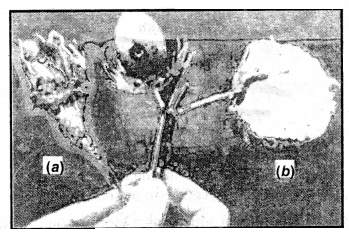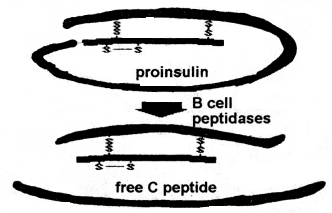By going through these CBSE Class 12 Biology Notes Chapter 12 Biotechnology and its Applications, students can recall all the concepts quickly.
Biotechnology and its Applications Notes Class 12 Biology Chapter 12
→ Biotechnology is the interaction between technology and biology. It is as old as human civilization. It may be defined as ‘The controlled use of biological agents, such as micro-organisms or cellular components, for beneficial use’. It deals with the industrial-scale production of biopharmaceuticals using genetically modified organisms.
→ The main objectives of biotechnology are:
- providing the best catalyst (improved organism) like a pure enzyme or some micro¬organism,
- Creating optimum conditions for the catalyst to perform,
- Downstream processing techniques for the purification of the organic compound.
→ Food production can be increased in three ways,
- Agrochemical based agriculture,
- Organic agriculture,
- Genetically engineered crop-based agriculture.
Crop yields are increased by using improved crop varieties and agrochemicals maximise the yield.
→ Genetically Modified Organisms (GMO) are plants, bacteria, fungi and animals whose genes are altered for human or animal consumption using the latest molecular biology techniques. The genetic modifications have made crops more tolerant to abiotic stresses like cold, drought, salt, heat etc.; reduced reliance on chemical pesticides by making pest-resistant crops, helped to reduce post-harvest losses, increased efficiency of mineral usage by plants, enhanced nutritional value of food, for example, vitamin A-rich rice.
The enhancement of desired traits has traditionally been undertaken through breeding, but conventional plant breeding methods can be very time consuming and are often not very accurate. Genetic engineering can create plants with the exact desired traits very rapidly and with great accuracy.
For example, geneticists can isolate a gene responsible for drought-tolerant and insert it into a different plant. The new genetically modified plant will gain drought tolerance. The characteristic of a genetically modified organism depends on the nature of genes transferred and the nature of the host plant as well as some regulatory environmental factors.
→ Recombinant DNA technology or genetic engineering is the latest technique that transfers one or more genes (DNA fragments) from one plant to another. The plant in which a foreign gene is introduced is called a transgenic plant. Two techniques are used to introduce foreign genetic material into the plant cell genome. One is through a vector and the other is direct introduction of DNA.
→ Several transgenic plants have been developed, one example is Bt cotton. Bt is a toxin produced by the bacterium Bacillus Thuringiensis. B toxin gene is cloned from bacterium and expressed in plants to provide resistance from insect without using insecticides. Thus by the application of biotechnology pest-resistant plants are developed. Some other examples are Bt com, Bt rice, Bt tomato, potato and soybean.
→ Bacillus Thuringiensis produces proteins that kill some insects like lepidopterans, e.g. tobacco budworm and armyworm, coleopterans like beetles, dipterans, e.g. flies and mosquitoes. B.Thuringiensis is a soil bacterium that forms some protein crystals which contain a toxic insecticidal protein that is present as inactive protoxin, when an insect ingests it, the inactive toxin is converted to the active toxin by the alkaline pH of the gut. The activated toxin bind to the surface of midgut epithelial cells and creates pores which cause swelling and lysis and ultimately death of the insect.
→ The toxin produced by B.thuringiensis is called Cry protein. The gene encoding Cry protein is called the Cry gene. There are several kinds of Cry proteins that are toxic to different groups of insects for example genes Cry-I AC and Cry-II Ab control the cotton bollworms, Cry-I Ab controls corn borer, Cry III Ab controls Colorado potato beetle and Cry-III Bb controls com rootworm.
→ Biotechnologists isolated the toxin-producing genes arid introduced into other crop plants with the help of Agrobacterium Ti-plasmid. These transgenic plants are resistant to insects and pests. Their prime advantage is the production of labour free insect protection of plants and also restrict the use of pesticides which helps in making soil and groundwater pollution-free.

Cotton boll (a) destroyed by bollworms and (b) a fully mature cotton boll (to be redrawn)
→ Another strategy is used to control nematode infestation of tobacco plant roots. Two normal nematode genes were introduced into the tobacco plant by the Agrobacterium vector. The tobacco plant makes a double-stranded RNA (dsRNA) with these genes. The dsRNA binds to mRNA and interfere with nematode RNA. This neutralises the nematode and it dies. The transgenic tobacco plant is protected from the parasite.
→ Modem biotechnology is contributing a lot to the field of medicine, for disease diagnosis and disease therapy. For example, insulin used to cure diabetes was earlier extracted from slaughtered cows and pigs, which may develop allergies. It was quite tiresome and difficult and the yield was very low.
Now by using recombinant DNA technology insulin can be produced by the fermentation of appropriate recombinant E.Coli clones. This method can produce large quantities of pure insulin in a short time and a small space. On 5th July 1983, an American firm Eli Lilly launched the first genetically engineered human insulin, which was named Humulin.
→ Insulin consists of 51 amino acids arranged in two short polypeptide chains viz. Chain A (21 amino acids) and Chain B (30 amino acids). Chain-A and Chain-B are linked together by (S-S) disulphide bridges.
proinsulin

Maturation of pro-insulin into insulin after removal of C-peptide (to be simplified)
In mammals, insulin is produced as a prohormone which contains an extra stretch of C-peptide. This C-peptide is removed during the processing and maturation of prohormone and produces functional and fully mature insulin.
In recombinant techniques, the genes corresponding to both chains A and B are introduced in plasmids of E.Coli, which produces insulin chains. Chain-A and Chain-B are produced separately, extracted and joined together by disulphide bonds. This produces human insulin.
→ Gene therapy is a collection of methods that allows the correction of a gene defect present in an embryo or a child. It involves the delivery of a normal gene into the individual to take over the function of the defective gene. A genetic disorder caused by a single defective gene can be corrected by replacing this with a normal gene. Some genetic diseases like severe combined immunodeficiency (SCID) can be cured using gene therapy.
The SCID patients have adenosine deaminase (ADA) deficiency, this enzyme is crucial for the immune system to function. The patient lacks functional T-lymphocytes and fails to fight the infecting pathogens. Children with ADA deficiency are cured by bone marrow transplantation or by enzyme replacement therapy, where ADA is given by injection. By using gene therapy techniques, lymphocytes are taken from the patient’s bone marrow and the normal gene for ADA is introduced into the lymphocytes using retrovirus. These cells are reintroduced in the patient’s immune system.
→ Polymerase Chain Reaction (PCR) helps a lot in the early diagnosis of a disease, prenatal disorders and even the presence of the HIV virus. It is a powerful technique to find many genetic disorders, suspected cancer patients, and disease before the arrival of the symptoms. Genetic cloning helps in developing sensitive diagnostic techniques like ELISA and to identify a normal mutant gene.
→ Transgenic animals have their DNA manipulated to contain and express an extra or foreign gene. These are produced for various reasons like to study the process of gene regulation, how gene help in the development of diseases like cancer, Alzheimer etc., to produce useful biological products for humans, for testing medicines and vaccines before using them for humans, for testing the toxicity of any new drug in less time.
→ Intellectual Property Right (IPRs) are the rights to make, use and sell a new product or technology for 20 years. A patent is an official document to give all rights to make, use or sell an invention and prevent others from copying it.
→ Biopatents are government protection for biological agents and their products. It can be granted for genetically modified microbes, newly established cell times, genetically modified plants and animals, gene sequences, protein sequences, biotechnological procedures, production processes, new products and production applications.
→ Biopiracy is the use of bio-resources and genetic resources indigenous to a country by some organisations without proper authorisation or compensatory payment. Bio-piracy is widespread in Asia, Africa and Latin America which have the most diverse ecosystems in the world and produce abundant bio-resources.
→ Genetically modified crops and organisms have found higher acceptance in industry and agriculture but these deprive farmers to use their year’s harvest as seed for next year or share it with someone else. The plant variety protection and Farmer’s Right Act grants plant breeders, right on a new variety of seeds. The Farmer’s Rights Act has granted farmers to save, use, sow, and exchange, share or sell their farm product.
→ Antibiotics: An antibiotic is an organic compound produced by a microorganism that inhibits the growth of the other-micro organism.
→ Antisense nucleic acid: This is single-stranded molecules of DNA or RAN which base pairs with mRNA of virus and block their translation.
→ Bt cotton: It is a variety of cotton which contains the Bt toxin from Bacillus thuringienSis that kills certain insects.
→ Biopiracy: Biopiracy is the theft of biological and genetic resources without proper authorisation or compensation from the concerned countries.
→ Biopatent: Biopatents are patents given to biological agents and their products, exclusive right for their manufacturing, using and selling fr a specific period.
→ DNA vaccines: DNA vaccines use one or more isolated genes of a pathogen. incorporate into plasmids and inject them into the muscle or delivered into the human body.
→ Enzymes: Enzymes are bio-catalysis which catalyse biological reactions without undergoing any change. They are proteinaceOuS in nature.
→ Humulin: Humulin is a commercial name given to human insulin.
→ Monoclonal antibodies: Monoclonal antibodies are derived from a single parent and are specific for antigens.
→ Probe: A probe is a piece of single-stranded DNA that is tagged with a radioactive molecule.
→ Recombinant proteins: These are proteins produced by transgenes. These are used to treat diseases and as vaccines.
→ Stem cells: The cells of a young embryo are called stern cells. These are pluripotent i.e.: they can transform into any of 220 cell types of the human body.
→ Steroids: Steroids are complex crystallisable lipids of high molecular weight which possess a tetracyclic hydrocarbon core and along side chain, e.g. cholesterol.
→ Transgenic organisms: These are organisms that have had their DNA manipulated to contain and express an extra (foreign) gene.
→ Terminator seeds: The seeds produced by genetic engineering develop into fertile parents but produce non-germinable seeds.
→ Vaccines: Vaccine ¡sa liquid containing dead or attenuated pathogen or its antigen which provides temporary or permanent immunity to a disease.
→ Vitamins: Vitamins are accessory food factors that are required in small quantities for various metabolic processes of the body.